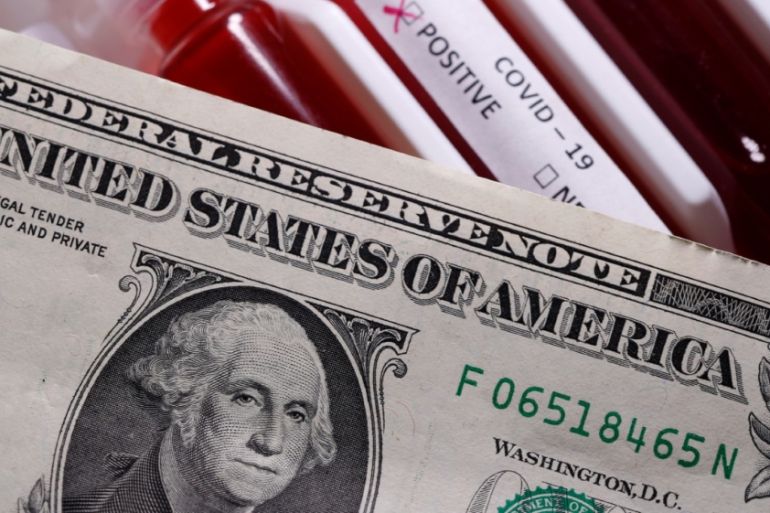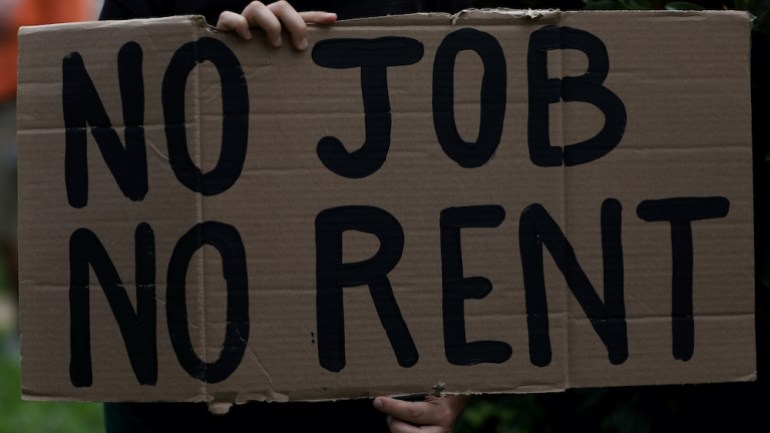Would Biden’s $1,400 stimulus cheques boost the US economy?
Researchers at the University of Pennsylvania estimate that nearly three-quarters of Biden’s $1,400 stimulus cheques would go directly into household savings.

While President Joe Biden is still trying to strike a bipartisan deal for a new round of COVID-19 relief aid, Democratic senators in the United States Congress are also laying the groundwork to approve his $1.9 trillion stimulus proposal without reaching a compromise with Republicans.
The negotiations are the latest chapter in the ongoing US stimulus saga that has left millions of out-of-work Americans and struggling small businesses guessing what will happen next.
Keep reading
list of 4 itemsBiden administration to provide COVID-19 vaccines to pharmacies
Democrats move to go it alone on Biden’s COVID-19 aid plan
Picking up steam, US firms add 174,000 jobs in January
One item that has sparked plenty of debate: the $1,400 stimulus cheques that Biden has proposed sending directly to Americans.
How would those cash payments, and all the other financial lifelines in Biden’s plan, actually impact the world’s largest economy?
Researchers at the University of Pennsylvania published a detailed analysis this week to answer those questions. It’s part of the Penn Wharton Budget Model, which describes itself as a “sandbox” where policy ideas can be tested out. Here’s what they found.
What would Biden’s plan actually do for regular people like me?
TL;DR: send them money to help weather the COVID-19 crisis — and expand tax credits that would keep more money in their pockets. Those are the big-ticket items. Other notable items include help for the hungry, and people struggling to pay their rent. The plan also calls on Congress to increase the minimum wage to $15 an hour (the federal minimum wage right now is $7.25)

Money in my pocket sounds good. How much are we talking here?
For people who are out of work, the plan would boost the federal weekly top-up for state jobless benefits from $300 to $400, and expand the child and earned income tax credits so more people would qualify for them.
It would also give a $1,400 stimulus cheque to each qualifying person — including children and adult dependents.
Why is it called a “stimulus” cheque?
Because the idea is that people get the cheque and spend the money right away. This stimulates economic activity, given that consumer spending drives some two-thirds of US economic growth.
So would the $1,400 cheques deliver a major stimulus?
Not according to the Penn Wharton Budget Model researchers. Their analysis suggests that the proposed $1,400 relief payments “will produce only small stimulative effects”. That’s because they estimate that 73 percent of the direct cash transfer would go directly to household savings.
Put simply, Americans will choose to save rather than spend their stimulus cheques.
Does everyone get the full $1,400?
No. The benefit is phased out for individuals earning more than $75,000 per year and couples earning $150,000.
So who would benefit the most from these cheques?
According to the Penn Wharton model, 99 percent of households in the bottom 80 percent of incomes — including 100 percent of households in the bottom 40 percent — would qualify for direct aid including stimulus cheques, an expansion of the child tax credit and or an expansion of the earned income tax credit.
How would it help the least well-off households?
Penn Wharton researchers found that for those in the bottom 20 percent of the income distribution, stimulus cheques combined with the tax credit expansions “would boost after-tax incomes by over 50 percent”. That’s a huge impact.
How much is all this going to cost taxpayers?
That’s the thing — it’s not cheap. Penn Wharton researchers estimate the direct payments and tax credit expansions would cost US taxpayers $595bn total in 2021.
Stimulus cheques would make up $477bn of that. And they reckon that $348bn of that stimulus cheque outlay would go into people’s savings accounts.
The US already has an enormous budget deficit, and the last stimulus bill pushed it over $3 trillion.
Can the US foot the bill?
Republicans are arguing the US simply cannot afford Biden’s plan. They’ve proposed a much smaller stimulus package worth $618bn.
Does the Republican plan include stimulus cheques?
Yes, but they would be smaller – $1,000 instead of Biden’s $1,400 – and only the lowest-income earners would be eligible for them.
Is a $618bn package enough to help the economy?
Democrats — including Biden’s new Treasury Secretary Janet Yellen — say the Republicans’ package is not enough. They argue that the economy would have recovered sooner from the Great Recession had Congress not been so stingy with stimulus back in 2009, and that tight-fisted thinking now could prolonge the rebound from the pandemic.
“The benefits of acting now — and acting big — will far outweigh the costs over the long term,” Yellen said in a call with a bipartisan group of mayors on Wednesday.
What do the smart folks at Penn Wharton say?
The Penn Wharton analysis estimates Biden’s entire $1.9 trillion plan would increase the US’s gross domestic product (GDP – the value of all the goods and services produced by the economy) by 0.6 percent relative to the baseline this year.
But all that debt will eventually catch up to the US — and decrease GDP in 2022 by 0.2 percent and GDP in 2040 by 0.3 percent.

So how dire is the economic situation for Americans right now?
Consider this: 22 million Americans were thrown out of work last year at the start of the pandemic.
As of December, only about 12 million of those jobs had been recovered. That leaves the economy 10 million jobs in the hole still. And at 6.7 percent, the unemployment rate is nearly twice the level it was just before the pandemic struck the US last year.
That’s brutal. Are some workers getting hit harder than others?
Yes. Low-wage service sector workers, as well as African-American and Latino workers and women, have been disproportionately impacted by the pandemic.
Is everyone struggling?
No. Wall Street has hit record highs recently, and people who own assets – such as houses and stock portfolios – have generally fared better, as have white-collar workers who have been able to keep their jobs by working from home.

So bottom line — is Biden’s stimulus plan good for the economy?
Like anything in America’s deeply polarised political landscape, it depends on who you ask.
The non-partisan Congressional Budget Office (CBO) released its own predictions Monday showing that the US economy will grow 4.6 percent in 2021 after contracting 3.5 percent in 2020. CBO’s numbers, which don’t take into account Biden’s proposed stimulus plan, paint a rosier picture than the office initially predicted.
But CBO’s analysis still doesn’t see American employment getting back to pre-pandemic levels until 2024, which is why Yellen says Congress “desperately” needs to act on the next round of stimulus relief. Stay tuned.